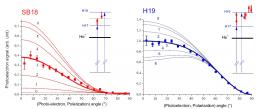
XUV+IR photoionization of He: Angular distributions (AD) of photoelectrons under side-band SB18 and main line H19; the angle refers to the linear polarization of the XUV and IR fields. AD result from interfering multiphoton channels; dominant (1-, 2-, 3-) photons channels indicated. Calculations at 1.2 1012 W/cm2 are shown for various XUV/IR delays, ranging from 0 to 10 units of time (1 unit of time is 4 a. u. = 96.756 as), as indicated on each curve. The calculated curves averaged over the delays are shown as thicker lines, for comparison with experimental points. The good agreement gives evidence of phase effect in the measured AD.
Collaborations : A. Huetz et al., Laboratoire d’Interaction des X Avec la Matière, CNRS Université Paris-Sud (Orsay, France)
Two-color XUV/IR ionization of rare gases has been investigated in so-called “complete experiments”, where all the momenta of electrons and ions from the same ionization event are simultaneously measured (vectorial correlations), using a momentum imaging spectrometer in the coincidence mode (developed by the LIXAM). In single photoionization (PI) of He, angular distribution evidences interferences between open channels [O. Guyétand et al., J. Phys. B 41, 051002 (2008)]. Interestingly, the interference depends on the attosecond delay between harmonics and laser pulses, as illustrated in the simulations in the figure, in good agreement with the delay-averaged experimental points. Conversely, angular distributions in PI can be used to characterize the XUV spectral phase, besides other methods such as RABBITT (see High Harmonic Generation and Attosecond physics).
In double ionization of Xe, two-electron angular distributions show sequential and possibly non sequential processes [O. Guyétand et al., J. Phys. B 41, 065601 (2008)]. Demonstration of vectorial correlations measurements with harmonics at kHz reprate is an important step for further studies in atomic/molecular multi-photon, two-color photoionization dynamics. Moreover, the fine control of the XUV spectral phase makes possible coherent control : the above study in He is a “simple” example of control.


